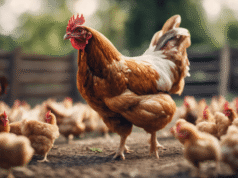Maintaining a clean and healthy environment is crucial for the well-being of your chickens. A key component of this is ensuring that the bedding in your chicken coop remains fresh. This article will explore various natural methods on how to keep chicken bedding fresh naturally, ensuring a healthy and comfortable habitat for your feathery friends.

The Importance of Fresh Bedding
Fresh bedding plays a significant role in the overall health of your chickens. It helps control odors, prevents the spread of diseases, and provides a comfortable resting place. Fresh bedding also minimizes moisture, which can lead to respiratory issues in chickens.
Why Choose Natural Methods?
Choosing natural methods to keep bedding fresh not only benefits the environment but also ensures the health of your chickens. Using natural remedies reduces the risk of exposing your chickens to harmful chemicals, promoting an organic lifestyle in your coop.
Types of Natural Bedding Materials
There are several types of natural bedding materials you can use in your chicken coop. Each has its unique benefits and can contribute to maintaining a fresh environment.
Straw and Hay
Straw and hay are popular choices for chicken bedding. They are absorbent and provide good insulation. However, they require regular replacement to prevent moisture buildup.
Wood Shavings
Wood shavings are another excellent option as they are highly absorbent and help control odors. Ensure you use untreated wood shavings to avoid harmful chemicals.
Sawdust
Sawdust is fine and absorbs moisture well but should be used with caution to prevent respiratory issues in chickens.
Maintaining Freshness in Bedding
Now that we have identified the types of bedding, let’s explore how to maintain their freshness naturally.
Regular Cleaning
Regular cleaning is crucial. Remove soiled bedding and replace it with fresh material. This simple step helps prevent ammonia buildup and keeps the coop smelling fresh.
Use Natural Herbs
Adding herbs like lavender, mint, and rosemary can help keep the bedding fresh. These herbs have natural antibacterial properties and provide a pleasant scent. Learn more about herbs that prevent molting stress in chickens.
Proper Ventilation
Ensure your coop is well-ventilated. Proper airflow reduces moisture and helps keep the bedding dry, preventing mold and mildew growth.
Diatomaceous Earth
Sprinkling food-grade diatomaceous earth on the bedding can help control pests and absorb moisture. Its a natural way to enhance the cleanliness of the coop.
Additional Tips
Deep Litter Method
The deep litter method involves allowing the bedding to form a compost layer over time. This method requires less frequent cleaning and provides natural heat during colder months.
Monitor Moisture Levels
Keep an eye on moisture levels in the coop. High moisture can lead to mold and bacteria growth. Use moisture-absorbing materials to combat this.
Regular Inspections
Conduct regular inspections of the coop to ensure the bedding remains fresh. Address any issues promptly to maintain a healthy environment.
Conclusion
Keeping chicken bedding fresh naturally is not only beneficial for your chickens but also for the environment. By choosing natural methods such as regular cleaning, using herbs, and maintaining proper ventilation, you can ensure a healthy and pleasant coop for your chickens. For more natural chicken care tips, visit how to clean a chicken coop naturally.

FAQ
1. How often should I change chicken bedding?
It depends on the size of your coop and the number of chickens, but generally, it’s recommended to change the bedding every 1-2 weeks.
2. Can I use hay as chicken bedding?
Yes, hay can be used as bedding, but it tends to retain moisture longer than straw or wood shavings.
3. Why is ventilation important in chicken coops?
Ventilation helps reduce moisture and ammonia levels, preventing respiratory problems and ensuring a fresh environment.
For further insights on maintaining a natural environment for your chickens, consider exploring natural remedies for viral infections in poultry.
This article contains affiliate links. We may earn a commission at no extra cost to you.











